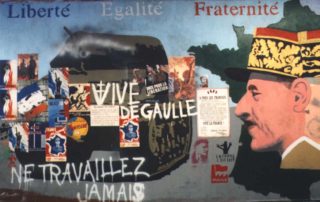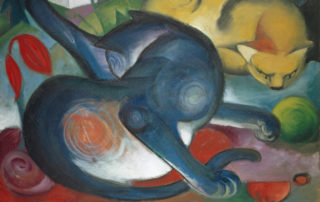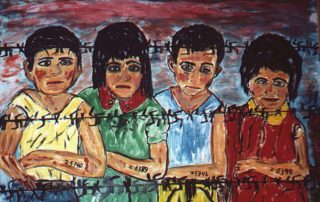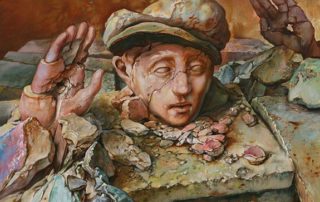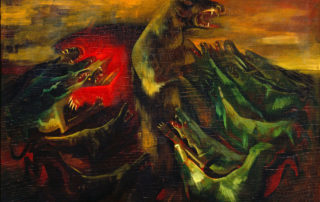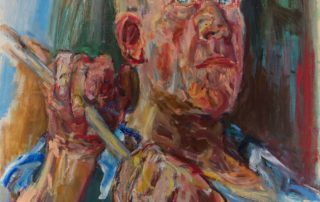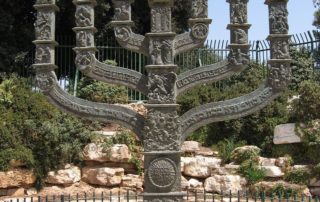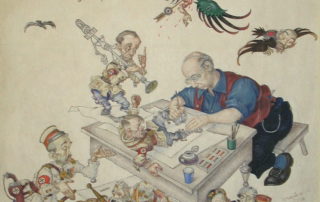Rachel Stern2023-02-15T19:21:41-05:00January 8th, 2023|Events, Lectures, Past Events|
Inspired by a visit to his birth country in the 1990s, American artist Philip Orenstein (b. 1938) created seven murals about the French complicity in the persecution of Jews in France during World War II. At that time, the French government had not admitted it had taken part in the persecution. The murals have been shown in various galleries and museums in the United States. In 1999, William Zimmer wrote in the New York Times, “Mr. Orenstein’s method involves combining poignancy with the determination that the viewers not miss the story. To this end, Mr. Orenstein skillfully, and wittily, employs the look of today’s splashy graffiti.” The works have not yet been shown in France. Born in Paris, France, in 1938, [...]
Rachel Stern2023-02-06T07:18:23-05:00January 8th, 2023|Events, Lectures, Past Events|
The Kunstmuseum Basel’s department of classic modernism houses one of the most prestigious collections of its kind. It was in fact assembled at a comparatively late date. In the summer of 1939 — shortly before the outbreak of World War II — Georg Schmidt (1896–1966), the museum’s director at the time, managed to acquire twenty-one avant-garde masterpieces all at once. The works were among those denounced in 1937 by Nazi cultural policy as “degenerate” and forcibly removed from German museums. The Third Reich’s Ministry of Propaganda correctly assumed that a portion of such works would find buyers abroad and bring in foreign currency. In this way certain artworks deemed “internationally exploitable” reached the art market via various channels. [...]
Rachel Stern2023-02-01T06:15:59-05:00December 1st, 2022|Events, Lectures, Past Events|
In honor of UN Holocaust Remembrance Day, Hilary Helstein, director of the award-winning documentary "As Seen Through These Eyes" spoke with Rachel Stern, director and CEO of the Fritz Ascher Society New York, about the making of her documentary. As poet Maya Angelou narrates this powerful documentary, she reveals the story of a brave group of people who fought Hitler with the only weapons they had: charcoal, pencil stubs, shreds of paper and memories etched in their minds. These artists took their fate into their own hands to make a compelling statement about the human spirit, enduring against unimaginable odds. Featuring interviews with Simon Wiesenthal as he talks about his art, never before appearing in a film, [...]
Rachel Stern2022-11-24T05:24:57-05:00November 10th, 2022|Events, Past Events|
In the aftermath of the Holocaust, the unprecedented destruction and plight of survivors prompts the unthinkable - German and Jewish leaders meet in secret to grapple with the first reparations in history, resulting in the groundbreaking Luxembourg Agreements of 1952. Screening followed by Q+A with Gideon Taylor and Karen Heilig, from the Conference on Jewish Material Claims Against Germany. Watch the Trailer: SCREENINGS In the aftermath of the Holocaust, German and Jewish leaders met in secret to negotiate the unthinkable – compensation for the survivors of the largest mass genocide in history. Survivors were in urgent need of help, but how could reparations be determined for the unprecedented destruction [...]
Rachel Stern2022-12-07T18:53:36-05:00May 25th, 2022|Events, Lectures, Past Events|
Image above: Samuel Bak, Warsaw Excavation, 2007. Oil on canvas, 16 x 20 in. Image Courtesy Pucker Gallery © Samuel Bak Samuel Bak was 6 years old when the Nazis began ending his childhood, as the war that they engendered would soon extend to his native Vilnius. The number “6” became an important element in his art, since it is also the number of the Commandment with which God enjoins us not to commit murder, for which the Holocaust represented such a profound abrogation. His father smuggled him out of the ghetto in the sack that he was still permitted to use to gather firewood—and was subsequently murdered by the regime. By then Bak himself had already [...]
Rachel Stern2022-05-19T05:21:58-04:00April 25th, 2022|Events, Lectures, Past Events|
Between 1933 and 1945, the National Socialist regime controlled artistic work in Germany. Particularly artists who were persecuted based on their religion, race, or political views fled into exile due to threats from the government. But what happened to the artists who remained in the country? Isolation, lack of an audience, and limited exchange impacted the creativity of the individuals who were deprived of a basis for work and life under National Socialism. Their situation is often described in a generalized way as “ostracism” or “inner emigration.” In light of the multilayered and divergent personal circumstances, however, these terms fall short of the mark. Image above: Hans Grundig, Clash of the Bears and Wolves, 1938, Oil on plywood, 90,5 [...]
Rachel Stern2022-02-18T06:38:48-05:00January 20th, 2022|Events, Lectures, Past Events|
Become part of an international community that actively helps build the largest digital memorial to the victims of National Socialism. During this 48 hour challenge, we help the Arolsen Archives index documents from the Central Location Index (CLI) at Yad Vashem, which have never been indexed before. Every number, every place, and every name you type in on the crowdsourcing platform will help preserve the memory of the persecutees – and make sure we never forget what happened to them. This event features Elizabeth Berkowitz, our former Digital Interpretation Manager, who speaks about #everynamecounts at the Fritz Ascher Society, and Katharina Menschick from the Arolsen Archives, who introduces the Arolsen Archives and the current project. A [...]
Rachel Stern2022-02-18T06:42:00-05:00May 11th, 2021|Events, Past Events|
Join the Fort Tryon Jewish Center (FTJC) and the Fritz Ascher Society for a LIVE DATA ENTRY EVENT to help build the world’s largest digital monument to victims of the Holocaust: the Arolsen Archives’ #everynamecounts. THIS EVENT WAS NOT RECORDED. Opening Remarks Rabbi Guy Austrian Fort Tryon Jewish Center in New York Rachel Stern Director and CEO of the Fritz Ascher Society in New York Introduction and Moderation Elizabeth Berkowitz Digital Interpretation Manager of the Fritz Ascher Society in New York #everynamecounts is a crowd-sourced data entry initiative to return the names of Holocaust victims, their families, and details of their lives into the findable, keyword-searchable public record. Participants enter information about Nazi victims and family members from digitized [...]
Rachel Stern2022-02-18T06:37:23-05:00March 4th, 2021|Events, Past Events|
The International Tracing Service (ITS), since 2019 called Arolsen Archives, was established by the Allies in 1948 as a central search and information center. They house the world’s most extensive collection of documents about the victims of National Socialist persecution, including documents from Nazi concentration camps, ghettoes and penal institutions, documents about forced laborers, and documents from the early post-war period about Displaced Persons, mainly Holocaust survivors, former concentration camp prisoners, and forced laborers. People who had fled the sphere of influence of the Soviet Union for political reasons are also included. The archive's holdings consist of 30 million documents in total and belong to UNESCO’s Memory of the World. At this event, Floriane Azoulay (Director) and Giora Zwilling (Deputy [...]
Rachel Stern2022-02-18T06:04:58-05:00March 3rd, 2021|Events, Lectures, Past Events|
The Austrian artist Oskar Kokoschka (1886-1980) achieved world fame with his intense expressionistic portraits and landscapes. Rüdiger Görner, author of the first English-language biography, depicts the artist in all his fascinating and contradictory complexity. He traces Kokoschka’s path from bête noire of the bourgeoisie and a so-called ‘hunger artist’ to a wealthy and cosmopolitan political and critical artist who played a major role in shaping the European art scene of the twentieth century and whose relevance is undiminished to this day. In 1934, Kokoschka left Austria for Prague, and in 1938, when the Czechs began to mobilize for the expected invasion by the German Wehrmacht, Kokoschka fled to the United Kingdom, where he remained during the war. Although he [...]
Rachel Stern2022-02-18T07:06:06-05:00February 22nd, 2021|Events, Lectures, Past Events|
Born 1877 in Dortmund, the sculptor Benno Elkan (1877-1960) first studied painting in Munich and Karlsruhe. At the end of his studies, he turned to sculpture. As a young artist, he spent time in Paris, Rome, and Frankfurt. Elkan’s oeuvre was largely made up of commissions. In the beginning, he mainly created tombs. Medals, portrait busts of well-known personalities, monuments to victims and candelabras follow, partly for the religious (Jewish and Christian) context. Elkan fled persecution by the German Nazi regime to Great Britain in 1934and lived with his family in London until the end of his life. Perhaps the most important work besides the Menorah in Jerusalem (1956) was never built: Memorial to the Defenseless Victims of the Bombing [...]
Rachel Stern2022-02-18T06:31:18-05:00February 17th, 2021|Events, Lectures, Past Events|
During the first four decades of the twentieth century, Polish Jewish artist Arthur Szyk (1894–1951) was best known for his richly detailed book illustrations and magnificent illuminations on Jewish themes. He portrayed the Jews as a heroic nation that had resisted oppression through the ages and eventually triumphed. His Jews were fighters for their own freedom and the freedom of others. Szyk sought to redefine how the Jews viewed themselves and how others viewed them. His works thus challenged the notion that Jewish history was merely one long saga of suffering and, at the same time, refuted the then common antisemitic canard that the Jews were a cowardly people. With the coming to power in Germany of Adolf Hitler [...]


